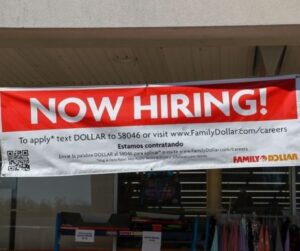The US job market has been hot, topping economists’ expectations for 11 months. But March might have turned the labor arena and the broader economy upside down. From a banking crisis to the Federal Reserve’s higher interest rates traveling throughout the economic landscape, many developments have revealed that cracks are starting to form in the US job market. Can employers keep adding to their payrolls a little longer until the Eccles Building eases monetary policy again? Perhaps it is a case of too little, too late.
US Job Market Slows in March
The US economy added 236,000 new jobs in March, down from an upwardly revised 326,000 positions in February, according to the Bureau of Labor Statistics (BLS). This came in below the market consensus of 239,000, the first time this has happened since March 2022. In addition, the gap between the household and establishment surveys was wide again, with the former reporting 166,731 new jobs. In total, the US economy has already added more than one million jobs this year.
The March unemployment rate eased to 3.5%, down from 3.6%, and matched economists’ expectations. The labor force participation rate inched higher to 62.6%, up from 62.5%. Average hourly earnings edged up 0.3% to $33.18, while average hourly earnings eased to 4.2% year-over-year. Average weekly hours dipped to 34.4, down from 34.5.
So, where were the jobs situated, and what industries trimmed the fat? Here is a breakdown of what occurred to close out the first quarter of 2023:
- Leisure and Hospitality: +72,000
- Government: +47,000
- Professional and Business Services: +39,000
- Health Care: +34,000
- Transportation and Warehousing: +10,000
- Retail: -15,000
- Manufacturing: -1,000
There was little change in several other sectors, including mining, construction, wholesale trade, information, and oil and gas extraction.
The reaction was muted on Wall Street after the numbers were published. The Dow Jones Industrial Average, the S&P 500, and the Nasdaq Composite Index were flat before the opening bell. The US Treasury market was mostly green, while the US Dollar Index, a gauge of the greenback against a basket of currencies, climbed above the 102.00 threshold.
Other Cracks Show
The non-farm payroll report being the worst reading in 27 months is unsurprising. In the days leading up to the widely watched data, there were indicators that conditions were slowing.
The Job Openings and Labor Turnover Survey (JOLTS) revealed that the number of job openings declined to 9.931 million in February, down from 10.563 million in January. Economists also penciled in a reading of 10.4 million. Moreover, this was the first time the JOLTS data saw hiring coming in below ten million in nearly two years. Job quits jumped above 4.024 million.
The Institute for Supply Management’s (ISM) Purchasing Managers’ Indexes also confirmed slowing employment last month. The ISM Manufacturing Employment sub-index fell to 46.9, down from 49.1 – anything below 50 indicates contraction. Likewise, the ISM Services Employment sub-index slumped to 51.2, down from 55.1.
Challenger, Gray and Christmas, Inc. figures highlighted that US-based employers announced nearly 90,000 job cuts in March, up 319% from the same time last year. By comparison, US companies announced plans to hire a little more than 9,000 workers last month, the lowest total for the month since 2015.

(Photo by Paul Weaver/SOPA Images/LightRocket via Getty Images)
“We know companies are approaching 2023 with caution, though the economy is still creating jobs. With rate hikes continuing and companies’ reigning in costs, the large-scale layoffs we are seeing will likely continue,” said Andrew Challenger, the senior vice president, in the monthly report. “The Technology sector is leading all industries, and this talent is in demand across industries. In fact, 38% of all cuts are in the Tech sector.”
The ADP National Employment Report showed that the private sector added 145,000 new jobs, down from 261,000 in February. This also came in under the estimate of 200,000. “Employers are pulling back from a year of strong hiring and pay growth, after a three-month plateau, is inching down,” said Nela Richardson, the chief economist at ADP.
Optimistic or Pessimistic for the Future?
The US job market is not perfect. Real wage growth (inflation-adjusted) is still negative. The manufacturing sector is in a recession and shedding payrolls. Millions are working multiple jobs to keep their heads above water. Continuing jobless claims are close to 1.9 million. Despite the rosy surface, the monthly BLS report validates the assertion by administration critics that many Americans are slipping through the cracks. In economics, it is stated that it takes about nine months for significant public policy decisions to travel through the system. It has been a year since the Federal Reserve started raising interest rates, but it has been only a month of roughly a 5% fed funds rate. Can the national economy handle a rising-rate climate? Many of the leading metrics point to a resounding no. But here is the kicker: the real interest rate (inflation-adjusted) is still negative, so another form of easy money is hopping across the country like the Easter Bunny.
All opinions expressed are those of the author and do not necessarily represent those of Liberty Nation.
Do you have an opinion about this article? We’d love to hear it! If you send your comments to [email protected], we might even publish your edited remarks in our new feature, LN Readers Speak Out. Remember to include the title of the article along with your name, city, and state.
Please respect our republishing guidelines. Republication permission does not equal site endorsement. Click here.

